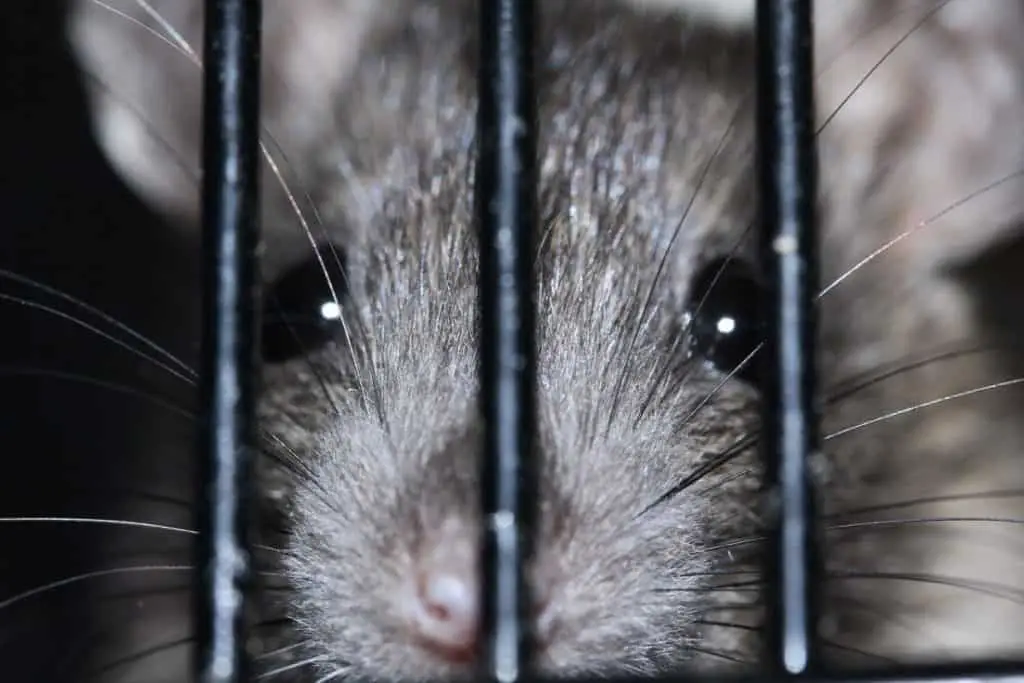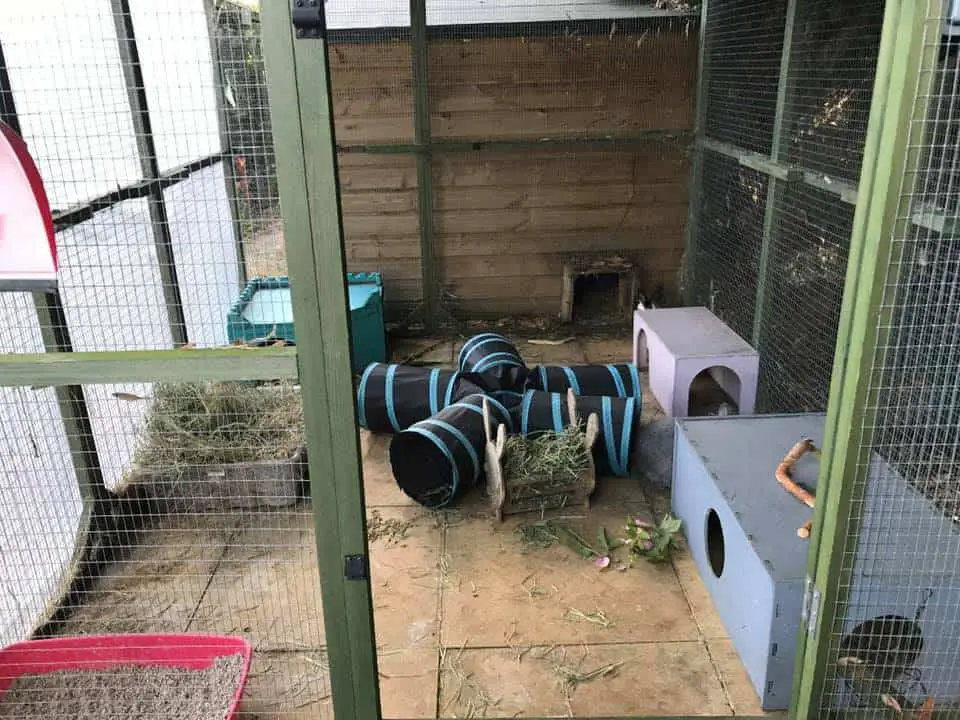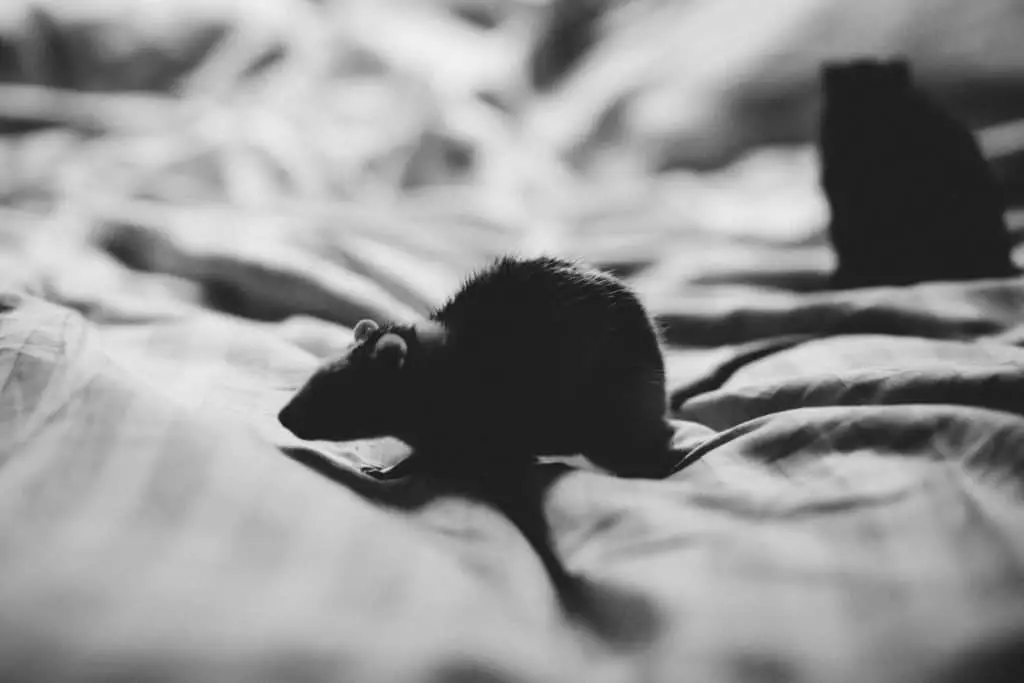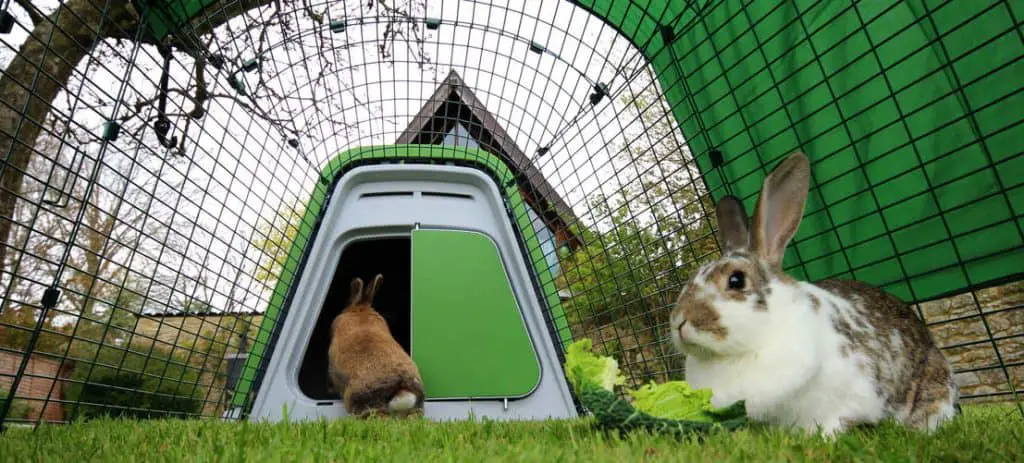Disclosure: We may earn money or products from the companies mentioned in this post.

Has a mouse or rat started hanging out with your rabbit for free food and shelter? Even if your bunny doesn’t seem to mind having mice in their cage, you need to get those mice and rats out of your rabbit hutch and keep them out! Throughout the years my family has kept rabbits we’ve dealt with lots of mouse invaders and in this article, I’ll share what we’ve learned.
Mice tend to hang out in rabbit hutches that are cluttered and dirty. Messy rabbit cages have lots of places for mice to hide and lots of bits of food that they can easily steal. A clean hutch is usually a mouse-free rabbit hutch.
Mice are a genuine threat to your rabbit’s health and safety and too many mice (and mouse droppings) can even pose a danger to you also.
In this article, I will share some handy tricks to keep mice away from your rabbit hutch.

Why Are Mice Attracted To A Rabbit Hutch?
Mice are attracted to rabbit hutches primarily because rabbit cages offer shelter and warmth; rabbit hutches are also full of rabbit food, comfy bunny bedding, and lots of places to hide. Deep piles of undisturbed bedding make an ideal habitat for mice.
Most problems with mice in rabbit cages occur during the winter months.
Like nearly every living animal, mice need shelter and warmth to survive cold weather. Mice also spend much of their wintertime in search of food. They can smell the food from far away. This smell lures them to your rabbit cage and once they know that food is frequently present there, they will start visiting the pen often.
After visiting your rabbit’s cage for food, if mice notice that your rabbit hatch is cozy, warm, and a peaceful place to live, they will move right in and might even decide to start a family in the depth of undisturbed rabbit bedding.
If your rabbit coop is filled with deep undisturbed bedding, it’s an open invitation to mice to move in. Your bunny’s bedding needs to be completely changed regularly.
~Stacey
Ideally, a rabbit bed is going to be a dark secure place where your rabbit can feel safe from threats. Sadly, this bed is also an ideal bead for mice.
A variety of materials is common to use as rabbit bedding, but what they all have in common is that they are warm and deep to give your bunny a place to dig in and sleep comfortably while feeling safe.
A rabbit’s diet and what a mouse eats are really one-in-the-same. That means that anything that you are feeding your bunny also is ideal mouse and rat food.
But it’s not just food that a mouse or rat get into your bunny’s cage to eat.
Mice possess coprophagic behavior, i.e., eating their own feces and that of their other animals. To complicate the matter, a rabbit’s feces usually has plenty of undigested nutrients (because they too are coprophagic).
If there is a lot of rabbit poop in your rabbit hutch, it can attract rodents nearly as strongly as piles of food.

Are Mice & Rats Dangerous To Rabbits?
We’re going to have to break this down into two separate questions.
First let’s consider mice and rabbits.
Mice are not a physical danger to your rabbit. Mice are not going to attack your adult rabbit. However, I have heard antidotal stories of mice attacking newborn bunnies, though I’ve not seen this firsthand. Mouse droppings do carry an infectious disease called Hantavirus pulmonary syndrome. Rabbits are not made sick by this disease, but they can become carriers which might put you at risk.
This means that while mice don’t pose a direct danger to your rabbit, they could prove to be a danger to you either directly or by infecting your bunny with a disease that could cause you severe breathing problems.
What about rats?
Rats will eat nearly anything and they have been known to attack newborn bunnies, but it’s quite rare. I’ve also seen rats attack small adult rabbits, but these were not attacks with the aim of killing or eating the rabbit. Instead, they were attacks caused by the rat feeling threatened. Rats do carry the same infectious disease that we talked about with mice.
To be clear, I’ve never seen a rat try to kill an adult rabbit of any size. I’ve seen them try to bite them, and even had one rabbit with a bite on his nose which I believe was from a rat. But I don’t believe a rat would go hunting an adult rabbit.
I’ve also seen dogs with rat bites on their nose. A cornered rat is will bite anyone nearby.

Can Rabbits Defend Themselves Against Rats?
Rabbits cannot effectively defend themselves from a rat bent on attacking. While rabbits can kick and bite, they are by nature prey not predators and have no real ability to cause serious harm to an attacking predator. However, rats very seldom actually attack adult rabbits with the intent to kill them.
That said, keep in mind that rats are not really predators either.
Instead, they are opportunists who will eat almost anything (including a very small rabbit) if hungry and giving the opportunity. Given space, rabbits will simply run away from a rat attack and be quite successful.
9 Ways To Keep Mice & Rat Out Of Your Rabbit Hutch:
Below is the mixture of old and new rabbit hacks that will help kick the mice out of the rabbit hutch and keep them out.
1. Clean Your Rabbit Hutch Thoroughly
Like your momma says, cleaning is the right solution to nearly every problem. So move the rabbits to a secure place, pick up your cleaning tools, and start cleaning.
Rabbits’ dropping should not be in hutch for a long time as it attracts mice. They will come to eat food scraps scattered near the rabbit. Despite your busy routine, regular cleaning of the hutch is necessary to keep mice out of your bunny’s cage.
2. Wash Rabbit’s Food Bowls Often
The least you can do to solve the mice problem is to wash food bowls for rabbits daily before and after the meal.
It will stop mice from visiting daily as food bowls with no food just won’t be attractive to them.
3. Remove The Food Before Sleep
After the bunnies finish their night feed, remove the excess food or the entire bowls from the hutch before sleep.
Rats and mice are by far most active at night so not having any food out at night will greatly reduce their chance of visiting your bunny’s cage.
You might think that rabbits need food in their hutch for late-night cravings, but remember that rabbits are not nocturnal.
If you leave rabbit food overnight in a bunny cage that you know has a mouse problem, it’s likely that more of that food be eating by mice and rats than by your bunny.

4. Keep Extra Food In Sealed Containers
Do not leave your supply of rabbit food in open sacks or containers. Instead, keep it in airtight containers to contain the smell and keep rats and mice from finding a way to get into the container (they can quickly chew through a feed bag).
If the rats and mice can’t smell your rabbit food, they won’t come into the hutch looking for it. { Click Here to see storage containers on Amazon. >>> }

5. Use Fleece Bedding
Using fleece blankets as bedding makes your rabbit hutch less messy and also makes it much less likely that mice will settle down in the hutch to raise a family. Fleece blanks are easy to clean and quick drying. Moreover, fleece provides a super comfortable environment for your bunny, which makes him healthy and joyful.
Most people use shredded paper, stray, or hay as bedding. All of these options can provide an ideal habitat for mice to nest if the bedding isn’t entirely cleaned out at least once every two weeks.
The downside with fleece bedding is that in cold and wet weather it should be monitored it ensure it’s not becoming moist which could cause your bunny to suffer from hypothermia which can be fatal.
6. Use Strong Metallic Cage Wire
Using high-quality wire, mesh, or lattice in your rabbit’s hutch to reduce mice inside your bunny’s cage. A mouse-proof cage is one of the best ways to assure that your rabbit will be protected from both mice and rats.
The wire on even the best rabbit hutches is large enough for mice and even rats to easily pass through. This leads many rabbit lovers with mouse problems to cover the outside of their rabbit hutch with chicken wire or something similar.
Chicken wire is too large to stop and mouse, but it a rat can’t normally fit through the holes in chicken wire. However, rats can easily chew through low gauge chicken wire.
Mice and especially rats tend to gnaw wires. Chewing is a common behavior of rodents. If they are desperately hungry, they can cut through low gauge wire with their teeth in no time and with no damage to themself.
Consider covering your rabbit hutch with high-quality welded wire mesh until you get your rodent problem under control. { Click here to see welded wire mesh on Amazon. >>> }
7. Inspect and Fill Mouse Sized Holes
Small mice can pass through a hole the size of a dime, and small rats through a hole the size of a nickel { Source }. If you’ve cleaned your hutch and still have a mouse problem, then it’s time to look for holes and patch them.
8. Put Lights Around Hutch
Mice and rats are primarily nocturnal animals (unlike rabbits that are crepuscular) which means they are most active in at night under the cover of darkness. In general, they don’t like to be exposed by lights.
So when the sun goes down, a light bulb near your rabbit hutch will discourage mice and rats from heading into the light.
The downside to this is that lights will make it harder for your rabbit to sleep at night. However, if you avoid very intense lights and make sure that your bunny’s bed is nice and dark, most rabbits do fine with a nightlight over their cage.
If your rabbit is having problems sleeping at night, you might have to remove the lights, but first, try some other tactics to get your rabbit to sleep at night.
9. Set Mouse & Rat Traps
All of the options up to this point have been to make your rabbit hutch less attractive for rodents, but if you have a large mouse or rat population in the area, then it’s probably time to reduce that population with traps.
Don’t use snare (snap) traps anywhere that animals other than the mice can get to the trap. This includes, your rabbit, other pets, and even wild birds.
Never use mice or rat poison around your rabbits.
Mouse and rat poison is not safe around rabbits. Any poison that will kill a rodent when they eat it will be attractive to your rabbit and will kill it too.
Also avoid sonic pest repellants around your bunny.
Sonic and ultrasonic electric pest repellents are not safe around rabbits. These devices emit a very high-pitched noise that we can’t hear, but mice, rats, and rabbits can easily hear and find at best uncomfortable and even painful.
Thankfully, there are other methods that work well while being safe to other animals and we’ll go into detail about those later.

Safe Mouse Traps Around Rabbits
The conventional way to catch a mouse is by using a spring or snap mousetrap and we suggest that you do not use these tried-and-true mouse traps around other animals, including rabbits, other pets, and even wild birds.
Many mouse traps are not safe to use around rabbits, including spring traps, snap traps, glue traps, electric traps, ultrasonic pest repellents, open-top water traps, and poison. The only rabbit-safe mouse/rat traps are cage mouse traps and closed bucket mouse traps.

1. Cage Mouse Traps
Cage mouse traps are small cages that a mouse or rat (depending on the size of the trap) can enter, but can not exit. Once in the trap, rodents remain there alive until released elsewhere or dispatched in some other manner.
I remember my grandfather using a ketch-all mousetrap in the chicken coop over forty years ago, and it’s still a great mousetrap. { Click Here to see the ketch-all mousetrap on Amazon. >>> }
Some people like these traps because they consider them humane because the mouse isn’t killed when captured. However, you are going to have to do something with that live mouse.
Remember that mice can travel a long ways to get back home, so you’re going to have to load that mouse into the car and take them miles from your home. Then you’re going to release that mouse in an unfamiliar area where it will be exposed to weather and predators. Finally, you’ll be taking your mouse problem and dumping it on someone else’s property.
Don’t judge me to harshly, but I’m a fan of the drowning attachment available for the ketch-all mousetrap. { Click Here to see this attachment on Amazon. >>> }
This is my favorite mouse trap because you seldom have just one mouse and this thing will easily catch four or five a night so you can get through your mouse problem more quickly and without handling each mouse.
If I thought I had a bigger mouse problem, I’d use the bucket trap below.

2. Closed Bucket Mouse Traps
Bucket or trashcan traps are another old and proven DIY mouse trap. In general, these traps are made of a large container filled with water and then baited to tempt mice and rats to fall into the water and drown. They work great and can reduce a rodent population really fast.
My family have used them around livestock for decades. However, you’d have to be very careful using them around rabbits.
Any bait you use for mice and rats will also be bait for your rabbit. And rabbits are not going to survive in that water bucket any longer than a rat would.
That means that you must be 100% sure that your rabbit can’t get to the bucket or you need to be pretty sure that your rabbit can’t reach the bucked AND you need to use a closed bucket with a hole that your rabbit won’t fit through.
I would not used an open bucket trap in the same area where my pet bunny lives or sometimes roams.
Instead, I’d suggest using the hole-in-one bucket trap. { Click Here to see a closed bucket trap on Amazon. >>> }
This is a rabbit safe mouse trap that can catch dozens of mice a night.
I hope this article will help you get rid of the mice in your rabbit cage and keep them away. If you have any other tried-and-true methods to deal with mice and rats, please let your fellow rabbit lovers know about it in the comments below.
~Stacey

Important legal notice: This post contains affiliate links. When you make a purchase through an affiliate link we make a small commission at no additional cost to you. Magic Meals LLC is a participant in the Amazon Associates affiliate program, as well as other affiliate programs including Siteground, Income School, Etsy, and many others. While we are always careful to only recommend the products we use and recommend, we want to be open and transparent about our relationship with the companies we recommend.

Great article! I do have a question however because my situation is a little different than most, My rabbits live indoors with me in a basement where, I am discovering as the weather gets colder, we have a mice problem. My rabbits are terrified, jumpy, nervous AND 2/3 of them are about to have surgery here in a couple weeks to be neutered. I can send you a picture of where they live but it is the tiled area by the sliding glass door. I need a solution ASAP! I did read about the bucket traps and such but I feel like a lot of these solutions are for outdoor hutches.
Sammi,
Bucket traps would work great indoors and can easily be dumped daily to avoid odor. I definitely recommend bucket traps starting ASAP.
Stacey